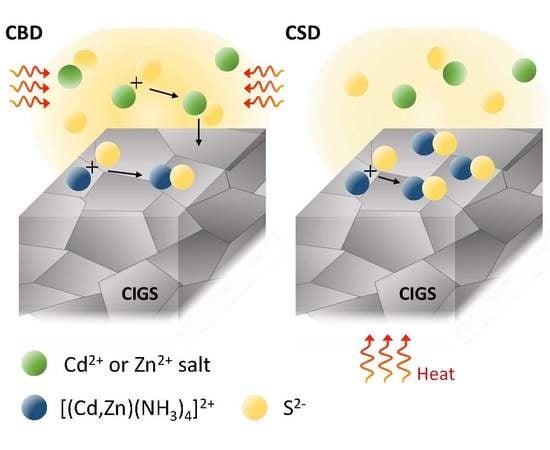A Comparative Study of (Cd,Zn)S Buffer Layers for Cu(In,Ga)Se2 Solar Panels Fabricated by Chemical Bath and Surface Deposition Methods
Abstract
1. Introduction
2. Materials and Methods
3. Results and Discussion
4. Conclusions
Supplementary Materials
Funding
Acknowledgments
Conflicts of Interest
References
- Powalla, M.; Paetel, S.; Hariskos, D.; Wuerz, R.; Kessler, F.; Lechner, P.; Wischmann, W.; Friedlmeier, T.M. Advances in Cost-Efficient Thin-Film Photovoltaics Based on Cu(In,Ga)Se2. Engineering 2017, 3, 445–451. [Google Scholar] [CrossRef]
- Mukati, K.; Birkmire, R.W.; Ogunnaike, B.A. Design and Control Considerations for Scale-up of a CIGS Inline Co-evaporative Physical Vapor Deposition Process. In Proceedings of the 2005 AlChE Annual Meeting, Cincinnati, OH, USA, 30 October–4 November 2005. [Google Scholar]
- Poortmans, J.; Arkhipov, V. Thin Film Solar Cells Fabrication, Characterization and Applications; Wiley Blackwell: Hoboken, NJ, USA, 2006; ISBN 9780470091289. [Google Scholar]
- Chantana, J.; Kato, T.; Sugimoto, H.; Minemoto, T. 20% Efficient Zn 0.9 Mg 0.1 O:Al/Zn 0.8 Mg 0.2 O/Cu(In,Ga)(S,Se)2 Solar Cell Prepared by All-Dry Process through a Combination of Heat-Light-Soaking and Light-Soaking Processes. ACS Appl. Mater. Interfaces 2018, 10, 11361–11368. [Google Scholar] [CrossRef]
- Tao, J.; Zhang, K.; Zhang, C.; Chen, L.; Cao, H.; Liu, J.; Jiang, J.; Sun, L.; Yang, P.; Chu, J. A sputtered CdS buffer layer for co-electrodeposited Cu2ZnSnS4 solar cells with 6.6% efficiency. Chem. Commun. 2015, 51, 10337–10340. [Google Scholar] [CrossRef]
- Lö, J.; Nishiwaki, S.; Andres, C.; Erni, R.; Rossell, M.D.; Romanyuk, Y.E.; Buecheler, S.; Tiwari, A.N. ALD-Zn x Ti y O as Window Layer in Cu(In,Ga)Se2 Solar Cells. ACS Appl. Mater. Interfaces 2018, 10, 43603–43609. [Google Scholar]
- Yoon, J.H.; Park, J.K.; Kim, W.M.; Lee, J.; Pak, H.; Jeong, J.H. Characterization of efficiency-limiting resistance losses in monolithically integrated Cu(In,Ga)Se2 solar modules. Sci. Rep. 2015, 5, 1–9. [Google Scholar] [CrossRef]
- Shah, N.A.; Rabeel, Z.; Abbas, M.; Syed, W.A. Effects of CdCl2 Treatment on Physical Properties of CdTe/CdS Thin Film Solar Cell. In Modern Technologies for Creating the Thin-film Systems and Coatings; InTech: Rijeka, Croatia, 2017. [Google Scholar]
- Bae, D.; Seger, B.; Vesborg, P.C.K.; Hansen, O.; Chorkendorff, I. Strategies for stable water splitting: Via protected photoelectrodes. Chem. Soc. Rev. 2017, 46, 1933–1954. [Google Scholar] [CrossRef]
- Liao, Y.-K.; Liu, Y.-T.; Hsieh, D.-H.; Shen, T.-L.; Hsieh, M.-Y.; Tzou, A.-J.; Chen, S.-C.; Tsai, Y.-L.; Lin, W.-S.; Chan, S.-W.; et al. Breakthrough to Non-Vacuum Deposition of Single-Crystal, Ultra-Thin, Homogeneous Nanoparticle Layers: A Better Alternative to Chemical Bath Deposition and Atomic Layer Deposition. Nanomaterials 2017, 7, 78. [Google Scholar] [CrossRef]
- Beisenherz, D. Equipment to enable GW-scale production of highly efficient CIGS Modules. In Proceedings of the 7th International Workshop on CIGS Solar Cell Technology, Munich, Germany, 23 June 2016. [Google Scholar]
- Nakada, T.; Mizutani, M. 18% Efficiency Cd-Free Cu(In, Ga)Se2 Thin-Film Solar Cells Fabricated Using Chemical Bath Deposition (CBD)-ZnS Buffer Layers. Jpn. J. Appl. Phys. 2002, 41, L165. [Google Scholar] [CrossRef]
- Kato, T. Cu(In,Ga)(Se,S)2 solar cell research in Solar Frontier: Progress and current status. Jpn. J. Appl. Phys. 2017, 56, 04CA02. [Google Scholar] [CrossRef]
- Hariskos, D.; Jackson, P.; Hempel, W.; Paetel, S.; Spiering, S.; Menner, R.; Wischmann, W.; Powalla, M. Method for a High-Rate Solution Deposition of Zn(O,S) Buffer Layer for High-Efficiency Cu(In,Ga)Se2-Based Solar Cells. IEEE J. Photovolt. 2016, 6, 1321–1326. [Google Scholar] [CrossRef]
- Hönes, C.; Hackenberg, J.; Keller, R.; Zweigart, S.; Fuchs, A.; Siebentritt, S. A Novel Fast Process for Zn(O,S) Buffer Layers, Doped with Al and B and Deposited on CIGSSe Solar Cells. IEEE J. Photovolt. 2017, 7, 864–869. [Google Scholar] [CrossRef]
- Laukaitis, G.; Lindroos, S.; Tamulevičius, S.; Leskelä, M. Stress and morphological development of CdS and ZnS thin films during the SILAR growth on (1 0 0)GaAs. Appl. Surf. Sci. 2001, 185, 134–139. [Google Scholar] [CrossRef]
- Yu, F.P.; Ou, S.L.; Yao, P.C.; Wu, B.R.; Wuu, D.S. Structural, surface morphology and optical properties of ZnS films by chemical bath deposition at various Zn/S molar ratios. J. Nanomater. 2014, 2014, 594952. [Google Scholar] [CrossRef]
- Garris, R.L.; Mansfield, L.M.; Egaas, B.; Ramanathan, K. Low-Cd CIGS Solar Cells Made with a Hybrid CdS/Zn(O,S) Buffer Layer. IEEE J. Photovolt. 2017, 7, 281–285. [Google Scholar] [CrossRef]
- Bae, D.; Gho, J.; Shin, M.; Kwon, S. Effect of zinc addition on properties of cadmium sulfide layer and performance of Cu(In,Ga)Se2 solar cell. Thin Solid Films 2013, 535, 162–165. [Google Scholar] [CrossRef]
- Rana, T.R.; Kim, S.Y.; Kim, J.H.; Kim, K.; Yun, J.H. A Cd-reduced hybrid buffer layer of CdS/Zn(O,S) for environmentally friendly CIGS solar cells. Sustain. Energy Fuels 2017, 1, 1981–1990. [Google Scholar] [CrossRef]
- Chavhan, S.D.; Senthilarasu, S.; Lee, S.H. Annealing effect on the structural and optical properties of a Cd1−xZnxS thin film for photovoltaic applications—ScienceDirect. Appl. Surf. Sci. 2008, 254, 4539–4545. [Google Scholar] [CrossRef]
- Chantana, J.; Kato, T.; Sugimoto, H.; Minemoto, T. Thin-film Cu(In,Ga)(Se,S)2-based solar cell with (Cd,Zn)S buffer layer and Zn1-xMgxO window layer. Prog. Photovolt. Res. Appl. 2017, 25, 431–440. [Google Scholar] [CrossRef]
- Birkmire, R.W.; Shafarman, W.N.; Eser, E.; Hegedus, S.S.; McCandless, B.E.; Dobson, K.D.; Bowden, S. Processing Materials Devices and Diagnostics for Thin Film Photovoltaics: Fundamental and Manufacturability Issues; Final Report for 1 March 2005–30 November 2008; National Renewable Energy Laboratory: Golden, CO, USA, 2009.
- Shafarman, W.N.; Siebentritt, S.; Stolt, L. Cu(InGa)Se2 Solar Cells. In Handbook of Photovoltaic Science and Engineering; Luque, A., Hegedus, S., Eds.; John Wiley & Sons Ltd.: Hoboken, NJ, USA, 2011; ISBN 0471491969. [Google Scholar]
- Il’chuk, H.; Shapowal, P.; Kusnezh, V. Chemical surface deposition of CdS ultra thin films from aqueous solutions. In Solar Cells—Thin-Film Technologies; Kosyachenko, L.A., Ed.; InTech: Rijeka, Croatia, 2011. [Google Scholar]
- Bae, D.; Kwon, S.; Oh, J.; Kim, W.K.; Park, H. Investigation of Al2O3 diffusion barrier layer fabricated by atomic layer deposition for flexible Cu(In,Ga)Se2 solar cells. Renew. Energy 2013, 55, 62–68. [Google Scholar] [CrossRef]
- Choi, I.H.; Choi, C.H.; Lee, J.W. Deep centers in a CuInGaSe 2/CdS/ZnO:B solar cell. Phys. Status Solidi Appl. Mater. Sci. 2012, 209, 1192–1197. [Google Scholar] [CrossRef]
- Lee, J.; Choi, C.; Kang, K.; Shin, M.; Kwon, S.; Yun, J.H. The effect of Na on CIGS module performance. J. Korean Phys. Soc. 2012, 60, 1997–2000. [Google Scholar] [CrossRef]
- Jia, G.; Wang, N.; Gong, L.; Fei, X. Growth characterization of CdZnS thin films prepared by chemical bath deposition. Chalcogenide Lett. 2009, 6, 463–467. [Google Scholar]
- Chun, S.; Han, K.S.; Lee, J.S.; Lim, H.J.; Lee, H.; Kim, D. Fabrication CdS thin film and nanostructure grown on transparent ITO electrode for solar cells. Curr. Appl. Phys. 2010, 10, S196–S200. [Google Scholar] [CrossRef]
- Li, J.; Huang, L.; Hou, J.; Wu, X.; Niu, J.; Chen, G.; Gong, J.; Kong, Y.; Xiao, X. Effects of substrate orientation and solution movement in chemical bath deposition on Zn(O,S) buffer layer and Cu(In,Ga)Se2 thin film solar cells. Nano Energy 2019, 58, 427–436. [Google Scholar] [CrossRef]
- Hodes, G. Substrate effects in chemical bath deposition. In Chemical Solution Deposition of Semiconducting and Non-metallic Films: Proceedings of the International Symposium; Lincot, D., Hodes, G., Eds.; The Electrochemical Society: Pennington, NJ, USA, 2003. [Google Scholar]
- Hashimoto, Y.; Kohara, N.; Negami, T.; Nishitani, N.; Wada, T. Chemical bath deposition of Cds buffer layer for CIGS solar cells. Sol. Energy Mater. Sol. Cells 1998, 50, 71–77. [Google Scholar] [CrossRef]
- Song, J.; Li, S.S.; Chen, L.; Noufi, R.; Anderson, T.J.; Crisalle, O.D. Investigation of CdZnS buffer layers on the performance of CuInGaSe2 and CuGaSe2 solar cells. In Proceedings of the IEEE 4th World Conference on Photovoltaic Energy Conversion (WCPEC-4), Waikoloa, HI, USA, 7–12 May 2006; IEEE: Waikoloa, HI, USA, 2006; pp. 534–537. [Google Scholar]
- Ihalane, E.; Atourki, L.; Alahyane, L.; Kirou, H.; Boulkaddat, L.; El, E.; Ihlal, A.; Bouabid, K. Numerical Simulation of Quantum Efficiency of Cd 0.8 Zn 0.2 S /CIGS Solar Cells. J. Technol. Innov. Renew. Energy 2014, 3, 195–198. [Google Scholar] [CrossRef]
- Hamri, Y.Z.; Bourezig, Y.; Medles, M.; Ameri, M.; Toumi, K.; Al-Douri, Y.; Voon, C.H.; Ameri, I. Improved efficiency of Cu(In,Ga)Se2 thinfilm solar cells using a buffer layer alternative to CdS. Sol. Energy 2019, 178, 150–156. [Google Scholar] [CrossRef]
- Bae, D.; Faasse, G.M.; Kanellos, G.; Smith, W.A. Unravelling the practical solar charging performance limits of redox flow battery based on the single photon device system. Sustain. Energy Fuels 2019, 3, 2399–2408. [Google Scholar] [CrossRef]
- Ghoneim, D. Inflence of zinc on optical, electrical and structural properties of (ZnxCd1-x)S films. Chalcogenide Lett. 2010, 7, 413–422. [Google Scholar]
- Song, J.; Li, S.S.; Yoon, S.; Kim, W.K.; Kim, J.; Chen, J.; Craciun, V.; Anderson, T.J.; Crisalle, O.D.; Ren, F. Growth and characterization of CdZnS thin film buffer layers by chemical bath deposition. In Proceedings of the Conference Record of the Thirty-First IEEE Photovoltaic Specialists Conference, Lake Buena Vista, FL, USA, 3–7 January 2005; pp. 449–452. [Google Scholar]
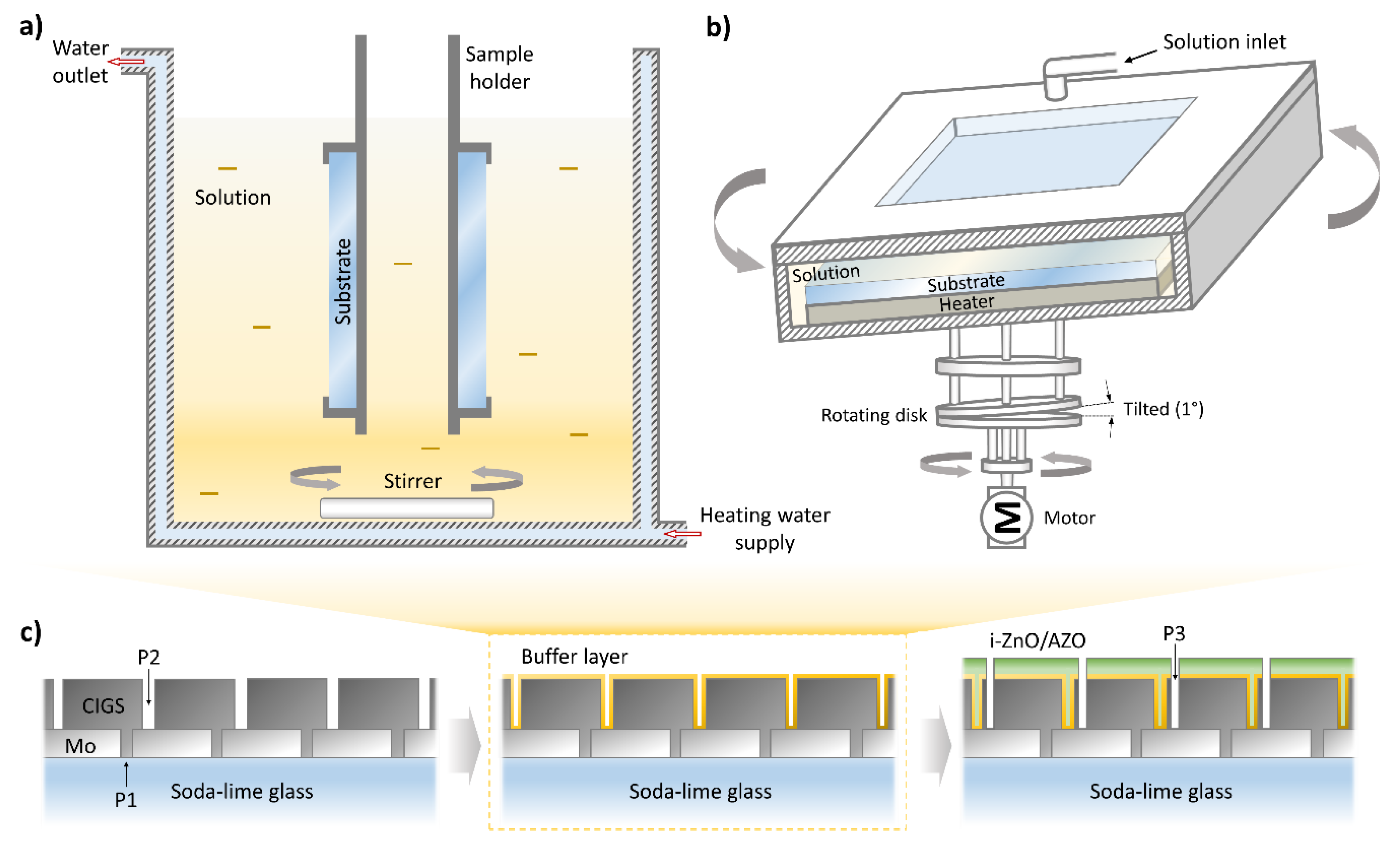
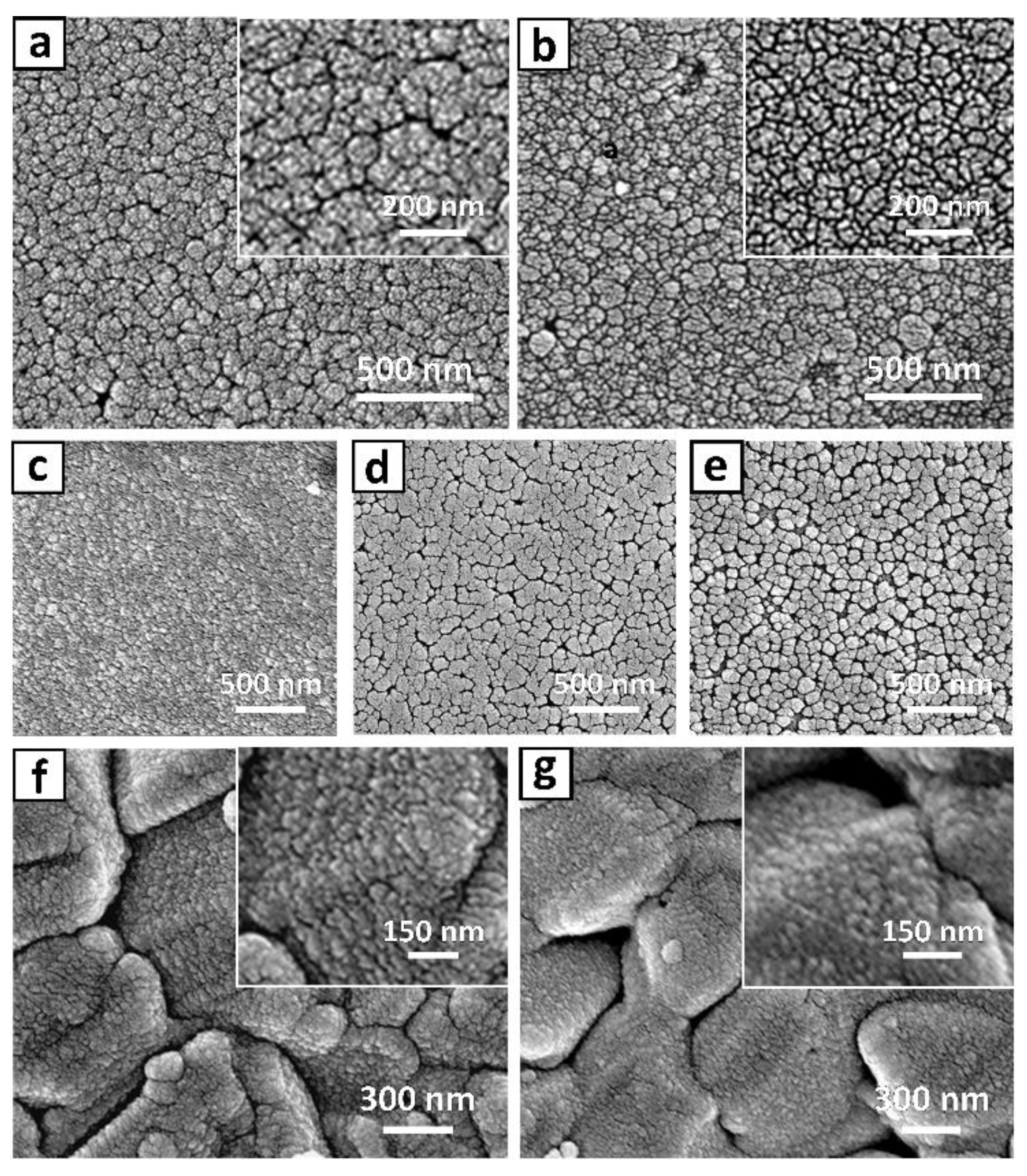

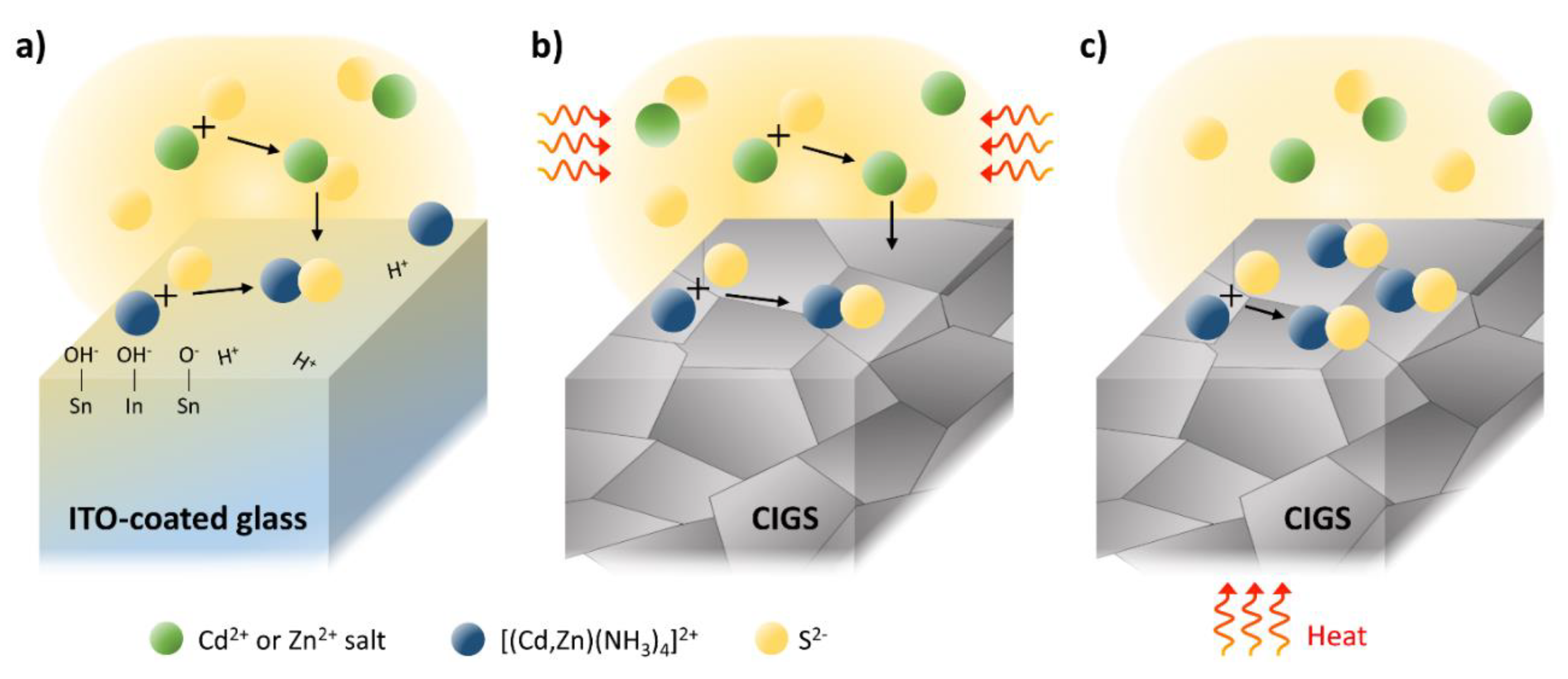
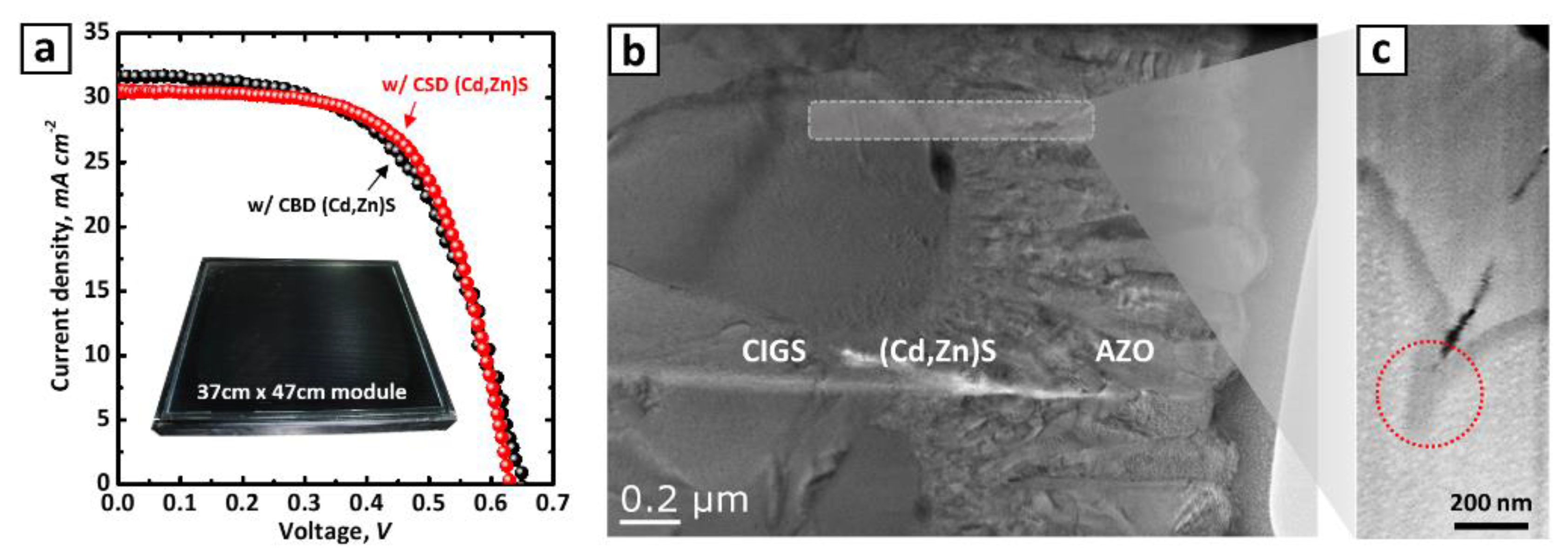
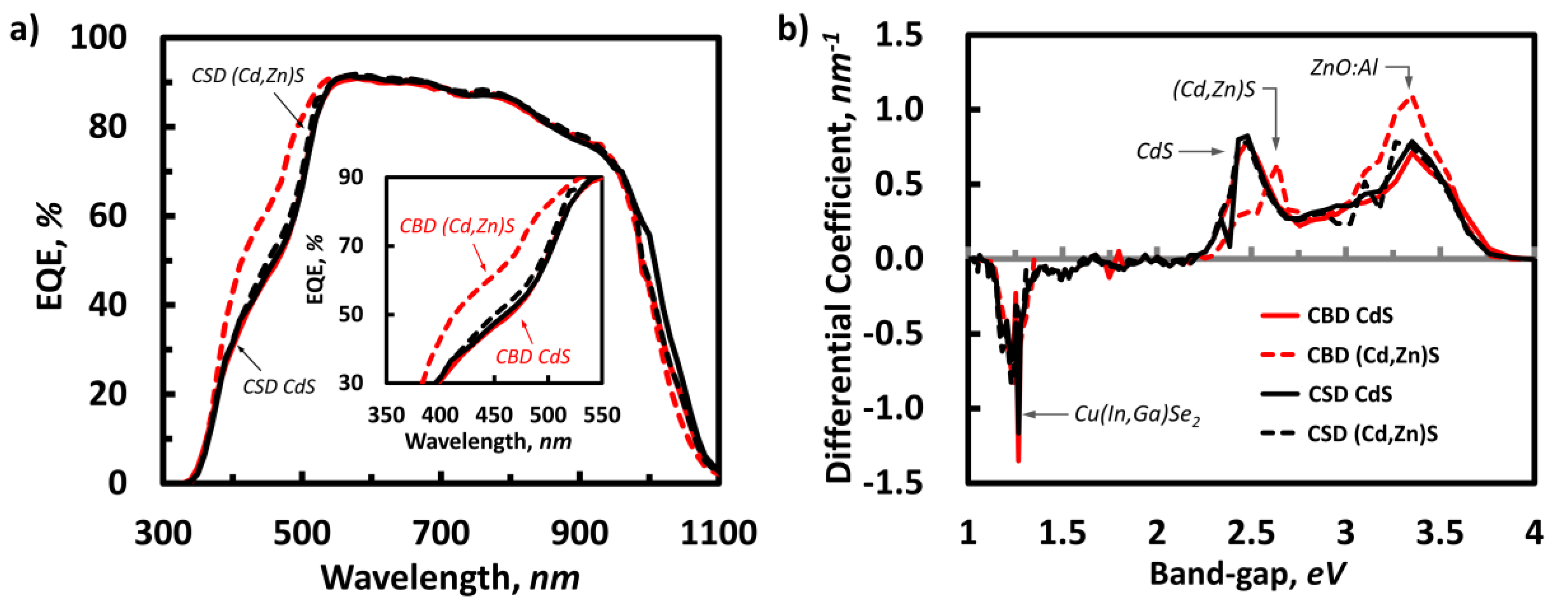
| Item | CBD Process | CSD Process |
|---|---|---|
| Chemical consumption * | ~20 liter m−2 [11] | ~6 liter m−2 |
| Heating method | Indirect (via electrolyte) | Direct |
| Flow type | Batch process | Semi-continuous |
| Deposition side | Double | Single |
| Scalability | Good | Limited |
| Method | Buffer Layer | Process Time (min) | Properties | ||
|---|---|---|---|---|---|
| Thickness 1 (nm) | Transmittance 2 (%) | Zn/(Cd+Zn) 3 | |||
| CBD | CdS | 16 | 70.42 ± 2.04 | 78.62 ± 2.27 | 0 |
| (Cd,Zn)S | 20 | 71.19 ± 3.47 | 84.79 ± 3.81 | 0.38 ± 0.04 | |
| CSD | CdS | 12 | 71.18 ± 2.45 | 77.74 ± 1.12 | 0 |
| (Cd,Zn)S | 16 | 72.37 ± 4.57 | 81.74 ± 2.96 | 0.27 ± 0.03 | |
| Method | Cd | S | Zn | Zn/(Cd + Zn) |
|---|---|---|---|---|
| CBD (Cd,Zn)S | 42.69 | 45.79 | 11.53 | 0.20 |
| CSD (Cd,Zn)S | 47.96 | 49.91 | 2.13 | 0.04 |
| Method | Buffer layer | Efficiency1 (%) | FF (%) | VOC/cell (V) | JSC (mA/cm2) | Rs (Ω cm2) | Rsh (Ω cm2) |
|---|---|---|---|---|---|---|---|
| CBD | CdS | 11.71 | 61.97 | 0.625 | 30.33 | 9.10 | 1123.02 |
| (Cd,Zn)S | 12.12 | 59.58 | 0.651 | 31.67 | 12.20 | 1882.13 | |
| CSD | CdS | 11.88 | 63.55 | 0.633 | 30.98 | 8.77 | 1291.09 |
| (Cd,Zn)S | 12.22 | 65.01 | 0.635 | 31.13 | 8.59 | 2185.53 |
© 2020 by the author. Licensee MDPI, Basel, Switzerland. This article is an open access article distributed under the terms and conditions of the Creative Commons Attribution (CC BY) license (http://creativecommons.org/licenses/by/4.0/).
Share and Cite
Bae, D. A Comparative Study of (Cd,Zn)S Buffer Layers for Cu(In,Ga)Se2 Solar Panels Fabricated by Chemical Bath and Surface Deposition Methods. Materials 2020, 13, 1622. https://doi.org/10.3390/ma13071622
Bae D. A Comparative Study of (Cd,Zn)S Buffer Layers for Cu(In,Ga)Se2 Solar Panels Fabricated by Chemical Bath and Surface Deposition Methods. Materials. 2020; 13(7):1622. https://doi.org/10.3390/ma13071622
Chicago/Turabian StyleBae, Dowon. 2020. "A Comparative Study of (Cd,Zn)S Buffer Layers for Cu(In,Ga)Se2 Solar Panels Fabricated by Chemical Bath and Surface Deposition Methods" Materials 13, no. 7: 1622. https://doi.org/10.3390/ma13071622
APA StyleBae, D. (2020). A Comparative Study of (Cd,Zn)S Buffer Layers for Cu(In,Ga)Se2 Solar Panels Fabricated by Chemical Bath and Surface Deposition Methods. Materials, 13(7), 1622. https://doi.org/10.3390/ma13071622




